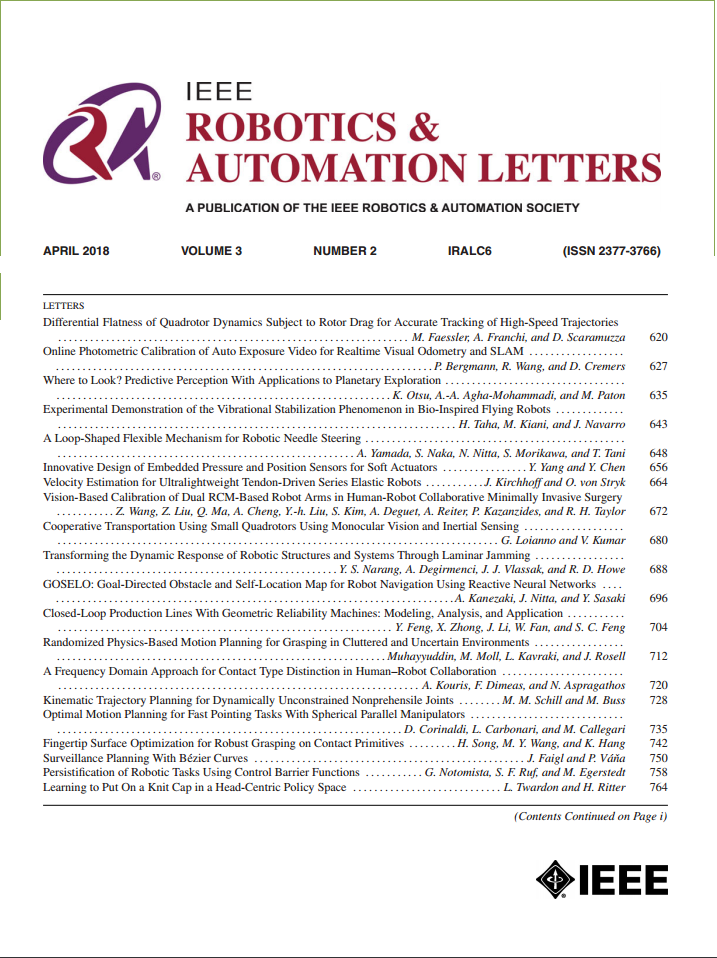Seeing Through Pixel Motion: Learning Obstacle Avoidance From Optical Flow With One Camera
IF 4.6
2区 计算机科学
Q2 ROBOTICS
引用次数: 0
Abstract
Optical flow captures the motion of pixels in an image sequence over time, providing information about movement, depth, and environmental structure. Flying insects utilize this information to navigate and avoid obstacles, allowing them to execute highly agile maneuvers even in complex environments. Despite its potential, autonomous flying robots have yet to fully leverage this motion information to achieve comparable levels of agility and robustness. The main challenges are two-fold: 1) extracting accurate optical flow from visual data during high-speed flight and 2) designing a robust controller that can handle noisy optical flow estimations while ensuring robust performance in complex environments. To address these challenges, we propose a novel end-to-end system for quadrotor obstacle avoidance using monocular optical flow. We develop an efficient differentiable simulator coupled with a simplified quadrotor model, allowing our policy to be trained directly through first-order gradient optimization. Additionally, we introduce a central flow attention mechanism and an action-guided active sensing strategy that enhances the policy's focus on task-relevant optical flow observations to enable more responsive decision-making during flight. Our system is validated both in simulation and the real world using an FPV racing drone. Despite being trained in a simple environment in simulation, our system demonstrates agile and robust flight in various unknown, cluttered environments in the real world at speeds of up to 6 m/s.透过像素运动:学习避障从光流与一个相机
光流捕获图像序列中像素随时间的运动,提供有关运动、深度和环境结构的信息。飞虫利用这些信息来导航和避开障碍物,使它们即使在复杂的环境中也能执行高度敏捷的机动。尽管有潜力,自主飞行机器人还没有充分利用这些运动信息来达到相当水平的敏捷性和鲁棒性。主要的挑战有两个方面:1)在高速飞行期间从视觉数据中提取准确的光流;2)设计一个鲁棒控制器,可以处理有噪声的光流估计,同时确保在复杂环境下的鲁棒性能。为了解决这些挑战,我们提出了一种新颖的端到端四旋翼避障系统,使用单目光流。我们开发了一个高效的可微模拟器与简化的四旋翼模型相结合,允许我们的策略直接通过一阶梯度优化进行训练。此外,我们引入了一个中心流注意机制和一个行动导向的主动感知策略,以增强政策对任务相关光流观测的关注,从而在飞行过程中做出更灵敏的决策。我们的系统在模拟和现实世界中使用FPV赛车无人机进行了验证。尽管在简单的模拟环境中进行了训练,但我们的系统在现实世界中各种未知、混乱的环境中以高达6米/秒的速度展示了敏捷和稳健的飞行。
本文章由计算机程序翻译,如有差异,请以英文原文为准。
求助全文
约1分钟内获得全文
求助全文
来源期刊

IEEE Robotics and Automation Letters
Computer Science-Computer Science Applications
CiteScore
9.60
自引率
15.40%
发文量
1428
期刊介绍:
The scope of this journal is to publish peer-reviewed articles that provide a timely and concise account of innovative research ideas and application results, reporting significant theoretical findings and application case studies in areas of robotics and automation.
 求助内容:
求助内容: 应助结果提醒方式:
应助结果提醒方式:


